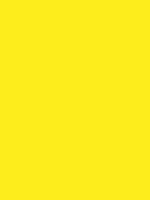#feed1d Color Information
In a RGB color space, hex #feed1d is composed of 99.6% red, 92.9% green and 11.4% blue. Whereas in a CMYK color space, it is composed of 0% cyan, 6.7% magenta, 88.6% yellow and 0.4% black. It has a hue angle of 55.5 degrees, a saturation of 99.1% and a lightness of 55.5%. #feed1d color hex could be obtained by blending #ffff3a with #fddb00. Closest websafe color is: #ffff33.
-
- R 100
- G 93
- B 11
-
- C 0
- M 7
- Y 89
- K 0
● #feed1d color description : Vivid yellow.
#feed1d Color Conversion
The hexadecimal color #feed1d has RGB values of R:254, G:237, B:29 and CMYK values of C:0, M:0.07, Y:0.89, K:0. Its decimal value is 16706845.
| Hex triplet | feed1d | #feed1d |
|---|---|---|
| RGB Decimal | 254, 237, 29 | rgb(254,237,29) |
| RGB Percent | 99.6, 92.9, 11.4 | rgb(99.6%,92.9%,11.4%) |
| CMYK | 0, 7, 89, 0 | |
| HSL | 55.5°, 99.1, 55.5 | hsl(55.5,99.1%,55.5%) |
| HSV (or HSB) | 55.5°, 88.6, 99.6 | |
| Web Safe | ffff33 | #ffff33 |
| CIE-LAB | 92.456, -13, 88.063 |
|---|---|
| XYZ | 71.38, 81.73, 13.178 |
| xyY | 0.429, 0.491, 81.73 |
| CIE-LCH | 92.456, 89.017, 98.398 |
| CIE-LUV | 92.456, 18.911, 98.419 |
| Hunter-Lab | 90.405, -17.272, 54.641 |
| Binary | 11111110, 11101101, 00011101 |
Color Schemes with #feed1d
Alternatives to #feed1d
Below, you can see some colors close to #feed1d. Having a set of related colors can be useful if you need an inspirational alternative to your original color choice.
#feed1d Preview
This text has a font color of #feed1d.
<span style="color:#feed1d;">Text here</span>This paragraph has a background color of #feed1d.
<p style="background-color:#feed1d;">Content here</p>This element has a border color of #feed1d.
<div style="border:1px solid #feed1d;">Content here</div>.text {color:#feed1d;}.background {background-color:#feed1d;}.border {border:1px solid #feed1d;}Shades and Tints of #feed1d
A shade is achieved by adding black to any pure hue, while a tint is created by mixing white to any pure color. In this example, #080800 is the darkest color, while #fffef4 is the lightest one.
-
#080800
#080800rgb(8,8,0) -
#1c1a00
#1c1a00rgb(28,26,0) -
#2f2c00
#2f2c00rgb(47,44,0) -
#433e00
#433e00rgb(67,62,0) -
#565000
#565000rgb(86,80,0) -
#6a6200
#6a6200rgb(106,98,0) -
#7e7401
#7e7401rgb(126,116,1) -
#918601
#918601rgb(145,134,1) -
#a59801
#a59801rgb(165,152,1) -
#b8aa01
#b8aa01rgb(184,170,1) -
#ccbc01
#ccbc01rgb(204,188,1) -
#dfce01
#dfce01rgb(223,206,1) -
#f3e001
#f3e001rgb(243,224,1)
-
#feeb09
#feeb09rgb(254,235,9) -
#feed1d
#feed1drgb(254,237,29) -
#feef31
#feef31rgb(254,239,49) -
#fef044
#fef044rgb(254,240,68) -
#fef258
#fef258rgb(254,242,88) -
#fef36b
#fef36brgb(254,243,107) -
#fef57f
#fef57frgb(254,245,127) -
#fff692
#fff692rgb(255,246,146) -
#fff8a6
#fff8a6rgb(255,248,166) -
#fff9b9
#fff9b9rgb(255,249,185) -
#fffbcd
#fffbcdrgb(255,251,205) -
#fffde0
#fffde0rgb(255,253,224) -
#fffef4
#fffef4rgb(255,254,244)
Tones of #feed1d
A tone is produced by adding gray to any pure hue. In this case, #959486 is the less saturated color, while #feed1d is the most saturated one.
-
#959486
#959486rgb(149,148,134) -
#9e9b7d
#9e9b7drgb(158,155,125) -
#a7a374
#a7a374rgb(167,163,116) -
#afaa6c
#afaa6crgb(175,170,108) -
#b8b263
#b8b263rgb(184,178,99) -
#c1b95a
#c1b95argb(193,185,90) -
#cac151
#cac151rgb(202,193,81) -
#d2c849
#d2c849rgb(210,200,73) -
#dbcf40
#dbcf40rgb(219,207,64) -
#e4d737
#e4d737rgb(228,215,55) -
#edde2e
#edde2ergb(237,222,46) -
#f5e626
#f5e626rgb(245,230,38) -
#feed1d
#feed1drgb(254,237,29)
Color Blindness Simulator
Below, you can see how #feed1d is perceived by people affected by a color vision deficiency. This can be useful if you need to ensure your color combinations are accessible to color-blind users.
